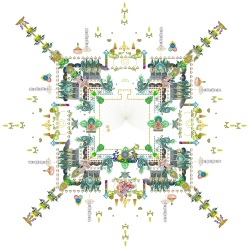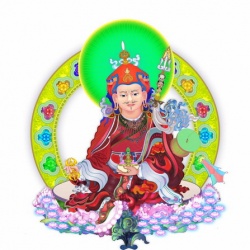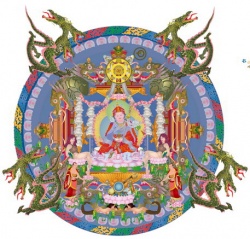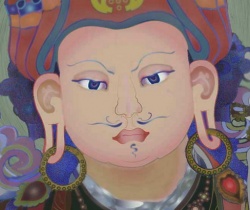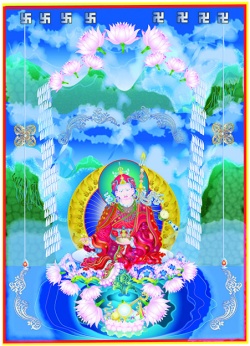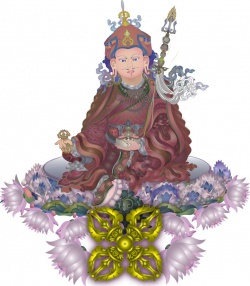Difference between revisions of "The Nyingma School"
(Created page with "<poem> The Nyingma school of Tibetan Buddhism traces its origins back to the Buddha Samantabhadra, Vajrasattva, and Garab Dorje of Uddiyana. The most ...") |
|||
| (One intermediate revision by the same user not shown) | |||
| Line 1: | Line 1: | ||
| + | [[File:Guru-Aed-mandala45.jpg|thumb|250px|]] | ||
<poem> | <poem> | ||
The [[Nyingma school]] of [[Tibetan Buddhism]] traces its origins back to the [[Buddha Samantabhadra]], [[Vajrasattva]], and [[Garab Dorje]] of [[Uddiyana]]. The most important source of the [[Nyingma]] order is the [[Indian]] [[Guru]], [[Padmasambhava]], the founder of the [[Nyingma Lineage]] of [[Tibetan Buddhism]], who came to [[Tibet]] in the eighth century C.E. | The [[Nyingma school]] of [[Tibetan Buddhism]] traces its origins back to the [[Buddha Samantabhadra]], [[Vajrasattva]], and [[Garab Dorje]] of [[Uddiyana]]. The most important source of the [[Nyingma]] order is the [[Indian]] [[Guru]], [[Padmasambhava]], the founder of the [[Nyingma Lineage]] of [[Tibetan Buddhism]], who came to [[Tibet]] in the eighth century C.E. | ||
| − | + | [[File:Guru-Detailid.jpg|thumb|250px|]] | |
NYINGMA SCRIPTURES | NYINGMA SCRIPTURES | ||
| − | The regular [[Buddhist canon]] common to all [[schools of Tibetan Buddhism]] consists of a collection of [[sutras]] and [[tantras]] and their commentaries, consisting of over three hundred and twenty volumes. To this, the [[canon]] of the [[Nyingma lineage]] adds the collection of the Hundred Thousand | + | The regular [[Buddhist canon]] common to all [[schools of Tibetan Buddhism]] consists of a collection of [[sutras]] and [[tantras]] and their commentaries, consisting of over three hundred and twenty volumes. To this, the [[canon]] of the [[Nyingma lineage]] adds the collection of the [[Hundred Thousand Nyingma Tantras]] known as “[[Nyingma Gyübum]],” and the collection of revealed [[scriptures]], known as [[Terma]]. |
| − | + | [[File:Guru-Draakonid.jpg|thumb|250px|]] | |
| − | The [[Terma]], or the [[Treasure | + | The [[Terma]], or the [[Treasure Transmission Lineage]] [[scriptures]], consists of {{Wiki|innumerable}} numbers of texts, such as The [[Great Treasury Of Precious Termas]], “[[Rinchen Terdzö]]” compiled by [[Jamgon Kongtrul]] the Great, [[Yonten Gyatso]] or [[Lodro Thaye]] (1813-1899). There have been numerous great [[Nyingmapa]] [[masters]] throughout the centuries, who have contributed in [[writing]] commentaries, instructions, [[dohas]] (spontaneous [[vajra]] songs), [[sadhanas]] and other writings in response to the needs of their students. Some of the most renowned later contributors to this collection include [[Rongzom]] [[Mahapandita]] (1012-1088), [[Kunkhyen]] [[Longchen]] Ramjam (1308-1363), Rikdzin [[Jikme Lingpa]] (1729-1798), [[Dzogchen Patrul]] (1808-1887), [[Lama]] [[Mipham]] (1846-1912), and [[Jikme Trinley Öser]] (1745-1821). The writings of these [[masters]] continue to be closely studied and practiced. |
| − | + | [[File:Guru-face.jpg|thumb|250px|]] | |
| − | PADMASAMBHAVA AND TIBETAN BUDDHISM | + | [[PADMASAMBHAVA]] AND [[TIBETAN BUDDHISM]] |
| − | [[King]] [[Trisong]] | + | [[King]] [[Trisong Deutsan]] (742-797) of [[Tibet]] invited [[Padmasambhava]] to [[Tibet]] in order to subdue the [[evil]] forces and establish the genuine teachings of the [[Buddha]]. Among [[Tibetans]], he is most well known as “[[Guru Rinpoche]],” or the “[[precious guru]].” He overcame {{Wiki|obstacles}} and [[evils]], [[transforming]] them into a positive field of [[energy]] that became [[fundamental basis]] for the spread of [[Buddhism]] in the Land Of Snow, [[Tibet]]. |
| − | + | [[File:Guru-järvel.jpg|thumb|250px|]] | |
The [[King]] had invited the Great [[Abbot]], [[Shantirakshita]], to help establish [[Buddhism]] in [[Tibet]]. Arriving before [[Padmasambhava]], he had advised the [[King]] to invite [[Padmasambhava]], since [[Tibet]] was facing intense {{Wiki|obstacles}} to the transplanting of the genuine [[Buddha-dharma]] in the country. | The [[King]] had invited the Great [[Abbot]], [[Shantirakshita]], to help establish [[Buddhism]] in [[Tibet]]. Arriving before [[Padmasambhava]], he had advised the [[King]] to invite [[Padmasambhava]], since [[Tibet]] was facing intense {{Wiki|obstacles}} to the transplanting of the genuine [[Buddha-dharma]] in the country. | ||
| + | [[File:Guru-Lootosel-65.jpg|thumb|250px|]] | ||
| + | The great [[Bodhisattva]] [[Abbot]] [[Shantarakshita]], [[Guru Padmasambhava]], and the [[King]] together completed the building of [[Samye monastery]], probably around 779 C.E.. [[Samye]] became the [[principal]] [[Buddhist]] center of {{Wiki|learning}} and also the place where many of the [[Indian]] [[Buddhist texts]] were first translated into [[Tibetan]], the beginning of the creation of a vast [[Buddhist]] {{Wiki|literature}} in [[Tibet]]. | ||
| − | + | For many years, [[Abbot]] [[Shantirakshita]] and [[Guru Rinpoche]] [[taught]] [[sutra]] and [[tantra]] extensively in [[Tibet]]. [[Guru Rinpoche]] [[taught]] the [[highest]] classes of the [[tantras]] to his twenty-five [[principal]] [[disciples]]. These [[disciples]] became the first wave of [[Tibetan]] [[yogis]] to attain [[realization]]; their supreme [[spiritual]] accomplishments benefited countless [[sentient beings]]. | |
| − | + | [[Vimalamitra]], a contemporary [[Indian]] [[master]], came to [[Tibet]] around the same [[time]]. He also [[taught]] many [[tantras]], and produced many [[realized]] [[disciples]] in [[Tibet]] who later continued the [[lineage]] to [[benefit]] [[infinite]] [[beings]]. | |
| − | [[ | + | [[Guru Padmasambhava]] hid hundreds of teachings and instructions as [[treasures]], in the [[forms]] of [[scriptures]], images, and [[ritual]] articles, to be revealed at an appropriate [[time]] in the {{Wiki|future}}. He saw that though the [[time]] was not ripe for him to teach them at that [[time]], many of the teachings would [[benefit]] {{Wiki|future}} generations. Since that [[time]], more than one hundred [[tantric]] [[masters]] have revealed these [[treasures]] and [[taught]] them, as instructed by [[Padmasambhava]], to their students. In this way, the [[Terma]] ([[revelation]]) [[lineage]] emerged. |
| − | [[ | + | THE [[NINE YANA]] JOURNEY |
| + | The [[Nyingma tradition]] classifies the corpus of [[Buddhist teachings]] into [[Nine Yanas]], among the [[highest]] of which is known as [[Atiyoga]] or [[Dzogchen]] ([[Great Perfection]]). | ||
| + | The [[Nine Vehicles]] are: the Three Common [[Vehicles]] – | ||
| − | + | (1) [[Shravaka-yana]], [[yana]] of the Hearers, | |
| − | + | (2) [[Pratyekabuddha-yana]], [[yana of the Solitary Realizers]], and | |
| + | (3) the [[Bodhisattva-yana]], the [[Mahayana]] (consisting mainly of the [[sutrayana]] teachings [[taught]] by [[Buddha Shakyamuni]]); the Three [[Outer Tantras]] – | ||
| + | (4) [[Kriya]] ([[Activity]]) [[Tantra]], | ||
| + | (5) [[Upa]] (Engagement) [[Tantra]], and | ||
| + | (6) [[Yoga]] (Practice) [[Tantra]] (the three stages of [[tantra]]); and the [[Three Innermost Tantras]] – | ||
| + | (7) [[Mahayoga]] (primarily consisting of [[Utpatikrama]] teachings), | ||
| + | (8) Annuyoga ({{Wiki|emphasizing}} [[Sampanakrama]]), | ||
| + | (9) [[Atiyoga]] (focusing on the most profound [[Sampranakrama]]). | ||
The first three are common to all [[schools of Buddhism]] and the next three are common to all schools of [[Tantric Buddhism]], whereas the last three are exclusive to the [[Nyingma tradition]]. | The first three are common to all [[schools of Buddhism]] and the next three are common to all schools of [[Tantric Buddhism]], whereas the last three are exclusive to the [[Nyingma tradition]]. | ||
| − | THE NYINGMA TANTRIC LINEAGES | + | THE NYINGMA TANTRIC [[LINEAGES]] |
According to the history of the origin of [[Nyingma]] [[tantras]], there are six types of [[lineage]]: | According to the history of the origin of [[Nyingma]] [[tantras]], there are six types of [[lineage]]: | ||
Three Common [[Lineages]] (of [[Kama]] and [[Terma]]): | Three Common [[Lineages]] (of [[Kama]] and [[Terma]]): | ||
| − | (1) The [[Thought]] [[Lineage]] of [[Buddhas]], the most original teachings of the [[Dharmakaya]] [[Buddhas]], originating from the [[primordial]] [[Buddha]], [[Samantabhadra]]. (2) The [[Symbolic]] [[Lineage]] of the [[Vidyadharas]] ([[Knowledge Holders]]), which refers to the teachings of the [[Sambhogakaya]] [[Buddhas]], originating from [[Vajrasattva]], to [[Vajrapani]] to [[Garab Dorje]] of [[Uddiyana]]. (3) The Ear-whispered [[Lineage]] Of The Great {{Wiki|Individuals}}, which are the teachings of the [[Nirmanakaya]] [[Buddha]], originating from the | + | (1) The [[Thought]] [[Lineage]] of [[Buddhas]], the most original teachings of the [[Dharmakaya]] [[Buddhas]], originating from the [[primordial]] [[Buddha]], [[Samantabhadra]]. |
| + | |||
| + | (2) The [[Symbolic]] [[Lineage]] of the [[Vidyadharas]] ([[Knowledge Holders]]), which refers to the teachings of the [[Sambhogakaya]] [[Buddhas]], originating from [[Vajrasattva]], to [[Vajrapani]] to [[Garab Dorje]] of [[Uddiyana]]. | ||
| + | |||
| + | (3) The Ear-whispered [[Lineage]] Of The Great {{Wiki|Individuals}}, which are the teachings of the [[Nirmanakaya]] [[Buddha]], originating from the [[Five Buddha families]] to the great [[human]] [[emanation]] [[master]] [[Garab Dorje]], and then to [[Manjushrimitra]], [[Shrisimha]], [[Padmasambhava]], [[Jnanasutra]], [[Vimalamitra]] and [[Vairochana]]. This [[lineage]] then started and continued in [[Tibet]], and continues through the {{Wiki|present}} day. | ||
Three Specific [[Lineages]] (of [[Terma]]): | Three Specific [[Lineages]] (of [[Terma]]): | ||
| − | (4) the [[Lineage]] Of Prophesied Mandate (bk’a-babs lung-bstan-gyi-brgyud-pa), (5) [[Lineage]] [[Empowered]] By [[Enlightened]] [[Aspiration]] (smon-lam-dbang-bskur-gyi-brgyud- pa), and (6) the [[Lineage]] Of The [[Dakinis]]’ Seal of Entrustment (mkh’a-’gro-gtad-rgya’i-rgyud-pa). | + | (4) the [[Lineage]] Of Prophesied Mandate ([[bk’a-babs lung-bstan-gyi-brgyud-pa]]), |
| + | (5) [[Lineage]] [[Empowered]] By [[Enlightened]] [[Aspiration]] ([[smon-lam-dbang-bskur-gyi-brgyud- pa]]), and | ||
| + | (6) the [[Lineage]] Of The [[Dakinis]]’ Seal of Entrustment ([[mkh’a-’gro-gtad-rgya’i-rgyud-pa]]). | ||
| − | TRANSMISSION LINEAGES | + | TRANSMISSION [[LINEAGES]] |
| − | Generally, the [[Nyingma]] [[vajrayana]] [[transmission]] [[lineage]] is classified into three main groups: (1) [[Kama]] (bk’a-ma), [[Oral Transmission]] [[Lineage]]; (2) [[Terma]] ([[gter-ma]],) | + | Generally, the [[Nyingma]] [[vajrayana]] [[transmission]] [[lineage]] is classified into three main groups: |
| + | |||
| + | (1) [[Kama]] ([[bk’a-ma]]), [[Oral Transmission]] [[Lineage]]; | ||
| + | |||
| + | (2) [[Terma]] ([[gter-ma]],) [[Concealed Treasures Transmission]] [[Lineage]]; | ||
| + | |||
| + | (3) and [[Daknang]], ([[dag-snang]]) [[Visionary]] [[Lineage]]. | ||
These three are further summarized into two basic [[transmission]] [[lineages]]: | These three are further summarized into two basic [[transmission]] [[lineages]]: | ||
| + | |||
(1) The [[Oral Transmission]] [[Lineage]] – the unbroken [[oral lineage]] of the [[Dzogchen tantras]] of [[Mahayoga]], [[Anuyoga]], and [[Atiyoga]] and other associated texts belonging to these [[subjects]]. | (1) The [[Oral Transmission]] [[Lineage]] – the unbroken [[oral lineage]] of the [[Dzogchen tantras]] of [[Mahayoga]], [[Anuyoga]], and [[Atiyoga]] and other associated texts belonging to these [[subjects]]. | ||
| − | |||
| − | NYINGMA SEATS IN TIBET AND IN EXILE | + | (2) The [[Treasure]] [[Transmission]] [[Lineage]] – the [[treasures]] of instructional [[scriptures]], [[statues]], and other [[spiritual]] {{Wiki|artifacts}} hidden by the [[Guru Padmasambhava]] sometime in 8-9th century that are revealed later by many great [[Tertöns]], the [[Treasure Masters]], through their [[enlightened]] [[mind]] and [[meditative]] [[visions]]. |
| − | After the building of [[Samye]], no other big [[monastic]] {{Wiki|institutions}} were built in [[Tibet]] for many decades. In 1159, | + | |
| + | NYINGMA SEATS IN [[TIBET]] AND IN EXILE | ||
| + | After the building of [[Samye]], no other big [[monastic]] {{Wiki|institutions}} were built in [[Tibet]] for many decades. In 1159, [[Ka Dampa Desheg]] (1112-92) in 1159 founded [[Kathok Monastery]] in [[Kham]] region of [[eastern Tibet]], which was the beginning of the [[development]] of [[Six Major Seats of Nyingmapa]] in [[Tibet]]. In 1610, [[Rikdzin Ngaki Wangpo]] founded [[Thupten Dorje Drak Monastery]] also in the central region of [[Tibet]], not too far from [[Samye]]. In 1676, [[Ugyen Terdak Lingpa]] founded [[Ugyen Mindrolling Monastery]] in {{Wiki|central Tibet}}. In 1665, [[Rikdzin Kunsang Sherap]] founded the [[Palyul Namgyal Jangchup Ling]] [[Monastery]] in [[eastern Tibet]]. In 1685, [[Dzogchen Pema Rikdzin]] founded the [[Dzogchen Ugyen Samten Choöling]] [[Monastery]] in [[Derge]] [[Kham]], in eastern region of [[Tibet]]. In 1735, [[Zhalham Rapjampa]] founded the [[Zhechen Tenyi Dhargye Ling]] [[Monastery]] in [[eastern Tibet]]. | ||
Many of these [[monasteries]] were destroyed either in 1959, during the {{Wiki|communist}} invasion of [[Tibet]] or later at the [[time]] of {{Wiki|Cultural Revolution}}. They have now been rebuilt in full or in part with the help of devoted local [[Tibetans]] as well as support from the [[buddhist]] communities in [[China]], or outside. The [[masters]] from these [[monasteries]] have also established their exile seats in [[India]], [[Nepal]], and [[Bhutan]], from where they preserve and train younger generations of [[lamas]] and [[reincarnate]] [[masters]]. | Many of these [[monasteries]] were destroyed either in 1959, during the {{Wiki|communist}} invasion of [[Tibet]] or later at the [[time]] of {{Wiki|Cultural Revolution}}. They have now been rebuilt in full or in part with the help of devoted local [[Tibetans]] as well as support from the [[buddhist]] communities in [[China]], or outside. The [[masters]] from these [[monasteries]] have also established their exile seats in [[India]], [[Nepal]], and [[Bhutan]], from where they preserve and train younger generations of [[lamas]] and [[reincarnate]] [[masters]]. | ||
| − | PRESENT HEAD OF THE NYINGMA LINEAGE | + | PRESENT HEAD OF THE NYINGMA [[LINEAGE]] |
| − | [[His Holiness]] the [[Mindrolling Trichen Rinpoche]], is the present head of the [[Nyingma lineage]] and he has established the [[Mindrolling Monastery]] in Clementown, Dehradun, [[India]]. | + | [[His Holiness]] the [[Mindrolling Trichen Rinpoche]], is the {{Wiki|present}} head of the [[Nyingma lineage]] and he has established the [[Mindrolling Monastery]] in Clementown, {{Wiki|Dehradun}}, [[India]]. |
</poem> | </poem> | ||
{{R}} | {{R}} | ||
[http://kagyuoffice.org/buddhism/buddhism-in-tibet/the-nyingma-school/ kagyuoffice.org/buddhism/] | [http://kagyuoffice.org/buddhism/buddhism-in-tibet/the-nyingma-school/ kagyuoffice.org/buddhism/] | ||
[[Category:Nyingma]] | [[Category:Nyingma]] | ||
Latest revision as of 03:59, 28 October 2015
The Nyingma school of Tibetan Buddhism traces its origins back to the Buddha Samantabhadra, Vajrasattva, and Garab Dorje of Uddiyana. The most important source of the Nyingma order is the Indian Guru, Padmasambhava, the founder of the Nyingma Lineage of Tibetan Buddhism, who came to Tibet in the eighth century C.E.
NYINGMA SCRIPTURES
The regular Buddhist canon common to all schools of Tibetan Buddhism consists of a collection of sutras and tantras and their commentaries, consisting of over three hundred and twenty volumes. To this, the canon of the Nyingma lineage adds the collection of the Hundred Thousand Nyingma Tantras known as “Nyingma Gyübum,” and the collection of revealed scriptures, known as Terma.
The Terma, or the Treasure Transmission Lineage scriptures, consists of innumerable numbers of texts, such as The Great Treasury Of Precious Termas, “Rinchen Terdzö” compiled by Jamgon Kongtrul the Great, Yonten Gyatso or Lodro Thaye (1813-1899). There have been numerous great Nyingmapa masters throughout the centuries, who have contributed in writing commentaries, instructions, dohas (spontaneous vajra songs), sadhanas and other writings in response to the needs of their students. Some of the most renowned later contributors to this collection include Rongzom Mahapandita (1012-1088), Kunkhyen Longchen Ramjam (1308-1363), Rikdzin Jikme Lingpa (1729-1798), Dzogchen Patrul (1808-1887), Lama Mipham (1846-1912), and Jikme Trinley Öser (1745-1821). The writings of these masters continue to be closely studied and practiced.
PADMASAMBHAVA AND TIBETAN BUDDHISM
King Trisong Deutsan (742-797) of Tibet invited Padmasambhava to Tibet in order to subdue the evil forces and establish the genuine teachings of the Buddha. Among Tibetans, he is most well known as “Guru Rinpoche,” or the “precious guru.” He overcame obstacles and evils, transforming them into a positive field of energy that became fundamental basis for the spread of Buddhism in the Land Of Snow, Tibet.
The King had invited the Great Abbot, Shantirakshita, to help establish Buddhism in Tibet. Arriving before Padmasambhava, he had advised the King to invite Padmasambhava, since Tibet was facing intense obstacles to the transplanting of the genuine Buddha-dharma in the country.
The great Bodhisattva Abbot Shantarakshita, Guru Padmasambhava, and the King together completed the building of Samye monastery, probably around 779 C.E.. Samye became the principal Buddhist center of learning and also the place where many of the Indian Buddhist texts were first translated into Tibetan, the beginning of the creation of a vast Buddhist literature in Tibet.
For many years, Abbot Shantirakshita and Guru Rinpoche taught sutra and tantra extensively in Tibet. Guru Rinpoche taught the highest classes of the tantras to his twenty-five principal disciples. These disciples became the first wave of Tibetan yogis to attain realization; their supreme spiritual accomplishments benefited countless sentient beings.
Vimalamitra, a contemporary Indian master, came to Tibet around the same time. He also taught many tantras, and produced many realized disciples in Tibet who later continued the lineage to benefit infinite beings.
Guru Padmasambhava hid hundreds of teachings and instructions as treasures, in the forms of scriptures, images, and ritual articles, to be revealed at an appropriate time in the future. He saw that though the time was not ripe for him to teach them at that time, many of the teachings would benefit future generations. Since that time, more than one hundred tantric masters have revealed these treasures and taught them, as instructed by Padmasambhava, to their students. In this way, the Terma (revelation) lineage emerged.
THE NINE YANA JOURNEY
The Nyingma tradition classifies the corpus of Buddhist teachings into Nine Yanas, among the highest of which is known as Atiyoga or Dzogchen (Great Perfection).
The Nine Vehicles are: the Three Common Vehicles –
(1) Shravaka-yana, yana of the Hearers,
(2) Pratyekabuddha-yana, yana of the Solitary Realizers, and
(3) the Bodhisattva-yana, the Mahayana (consisting mainly of the sutrayana teachings taught by Buddha Shakyamuni); the Three Outer Tantras –
(4) Kriya (Activity) Tantra,
(5) Upa (Engagement) Tantra, and
(6) Yoga (Practice) Tantra (the three stages of tantra); and the Three Innermost Tantras –
(7) Mahayoga (primarily consisting of Utpatikrama teachings),
(8) Annuyoga (emphasizing Sampanakrama),
(9) Atiyoga (focusing on the most profound Sampranakrama).
The first three are common to all schools of Buddhism and the next three are common to all schools of Tantric Buddhism, whereas the last three are exclusive to the Nyingma tradition.
THE NYINGMA TANTRIC LINEAGES
According to the history of the origin of Nyingma tantras, there are six types of lineage:
Three Common Lineages (of Kama and Terma):
(1) The Thought Lineage of Buddhas, the most original teachings of the Dharmakaya Buddhas, originating from the primordial Buddha, Samantabhadra.
(2) The Symbolic Lineage of the Vidyadharas (Knowledge Holders), which refers to the teachings of the Sambhogakaya Buddhas, originating from Vajrasattva, to Vajrapani to Garab Dorje of Uddiyana.
(3) The Ear-whispered Lineage Of The Great Individuals, which are the teachings of the Nirmanakaya Buddha, originating from the Five Buddha families to the great human emanation master Garab Dorje, and then to Manjushrimitra, Shrisimha, Padmasambhava, Jnanasutra, Vimalamitra and Vairochana. This lineage then started and continued in Tibet, and continues through the present day.
Three Specific Lineages (of Terma):
(4) the Lineage Of Prophesied Mandate (bk’a-babs lung-bstan-gyi-brgyud-pa),
(5) Lineage Empowered By Enlightened Aspiration (smon-lam-dbang-bskur-gyi-brgyud- pa), and
(6) the Lineage Of The Dakinis’ Seal of Entrustment (mkh’a-’gro-gtad-rgya’i-rgyud-pa).
TRANSMISSION LINEAGES
Generally, the Nyingma vajrayana transmission lineage is classified into three main groups:
(1) Kama (bk’a-ma), Oral Transmission Lineage;
(2) Terma (gter-ma,) Concealed Treasures Transmission Lineage;
(3) and Daknang, (dag-snang) Visionary Lineage.
These three are further summarized into two basic transmission lineages:
(1) The Oral Transmission Lineage – the unbroken oral lineage of the Dzogchen tantras of Mahayoga, Anuyoga, and Atiyoga and other associated texts belonging to these subjects.
(2) The Treasure Transmission Lineage – the treasures of instructional scriptures, statues, and other spiritual artifacts hidden by the Guru Padmasambhava sometime in 8-9th century that are revealed later by many great Tertöns, the Treasure Masters, through their enlightened mind and meditative visions.
NYINGMA SEATS IN TIBET AND IN EXILE
After the building of Samye, no other big monastic institutions were built in Tibet for many decades. In 1159, Ka Dampa Desheg (1112-92) in 1159 founded Kathok Monastery in Kham region of eastern Tibet, which was the beginning of the development of Six Major Seats of Nyingmapa in Tibet. In 1610, Rikdzin Ngaki Wangpo founded Thupten Dorje Drak Monastery also in the central region of Tibet, not too far from Samye. In 1676, Ugyen Terdak Lingpa founded Ugyen Mindrolling Monastery in central Tibet. In 1665, Rikdzin Kunsang Sherap founded the Palyul Namgyal Jangchup Ling Monastery in eastern Tibet. In 1685, Dzogchen Pema Rikdzin founded the Dzogchen Ugyen Samten Choöling Monastery in Derge Kham, in eastern region of Tibet. In 1735, Zhalham Rapjampa founded the Zhechen Tenyi Dhargye Ling Monastery in eastern Tibet.
Many of these monasteries were destroyed either in 1959, during the communist invasion of Tibet or later at the time of Cultural Revolution. They have now been rebuilt in full or in part with the help of devoted local Tibetans as well as support from the buddhist communities in China, or outside. The masters from these monasteries have also established their exile seats in India, Nepal, and Bhutan, from where they preserve and train younger generations of lamas and reincarnate masters.
PRESENT HEAD OF THE NYINGMA LINEAGE
His Holiness the Mindrolling Trichen Rinpoche, is the present head of the Nyingma lineage and he has established the Mindrolling Monastery in Clementown, Dehradun, India.
